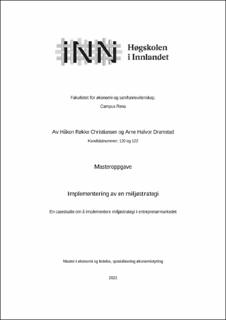| dc.contributor.advisor | | |
| dc.contributor.author | Christiansen, Håkon Røkke og Dramstad, Arne Halvor | |
| dc.date.accessioned | 2023-10-25T16:10:27Z | |
| dc.date.available | 2023-10-25T16:10:27Z | |
| dc.date.issued | 2023 | |
| dc.identifier | no.inn:inspera:144977927:147535110 | |
| dc.identifier.uri | https://hdl.handle.net/11250/3098743 | |
| dc.description.abstract | Denne masteravhandlingen er en kvalitativ casestudie av en norsk entreprenørvirksomhet der vi undersøker leders bruk av styringssystemet for å implementere en miljøstrategi. Vi har utformet følgende problemstilling:
Hvordan benyttes styringssystemet for å implementere en miljøstrategi?
Problemstillingen besvares ved at vi har utført et casestudie på en landsdekkende entreprenørbedrift. Vi valgte å samle inn data fra flere selskaper spredt over hele landet for å oppnå en dypere innsikt. I forskningsprosjektet inkluderte vi både konsernledelse, stab og ansatte i selskapene for å undersøke flere analysenivåer og få et mer helhetlig bilde av virksomheten. Dette består av informanter fra seks forskjellige selskaper i tillegg til stab og konsernledelse, som inkluderer både ledere og medarbeidere. I tillegg til intervjuene har vi utført en dokumentanalyse av offentlig tilgjengelige dokumenter fra entreprenørvirksomheten. Dette har gitt oss en dypere innsikt i både konteksten og miljøstrategien, samt hvordan entreprenørvirksomheten implementerer denne strategien. Vår forskningsprosess kan beskrives som en stegvis-deduktiv induktiv metode.
For å undersøke virksomhetens styringssystem i en økonomistyringssammenheng og i tillegg kartlegge bruk, har vi valgt å benytte det analytiske Simons (1995a) rammeverk «Levers of Control».
Vår studie viser at entreprenørvirksomheten implementerer miljøstrategien ved å ta i bruk de begrensende delene av styringssystemet – diagnostiske- og grensesystemer. Det viser et spesielt ensidig fokus av diagnostisk kontrollsystem i implementering av miljøstrategien gjennom en «top-down» prosess. Simons (1995a) påpeker imidlertid at virksomheter i tillegg burde benytte muliggjørende kontrollspaker for å sikre ytterligere motivasjon og engasjement i strategiimplementeringen, og tilrettelegge for kontinuerlige strategiske forbedringer. Derfor er det viktig å ha en helhetlig tilnærming til bruk av styringssystemet for å sikre en effektiv implementering av strategi. | |
| dc.description.abstract | This master’s thesis is a qualitative case study of a Norwegian contracting company where we investigate leaders’ usage of a management system to implement an environmental strategy. We have formulated the following research question:
How is the management system utilized to implement an environmental strategy?
The research question is answered by conducting a case study on a domestic, nationwide contracting company. We chose to collect data from several companies spread across the country to gain a deeper insight. In the research project, we included both the corporate management, the staff, and employees in the various companies to examine multiple levels of analysis and to get a more comprehensive picture of the organization. This includes informants from six different companies in addition to the corporate management and staff, including both leaders and employees. In addition to the interviews, we have conducted a document analysis of publicly available documents from the contracting company. This has given us a deeper understanding of both the context and the environmental strategy, as well as how the company is implementing this strategy. Our research process can be described as a stepwise-deductive inductive method.
To examine the company’s management system in an economic management context and to also map usage, we have chosen to use the analytical framework of Simons (1995a), “Levers of Control”.
Our study shows that the contracting company implements the environmental strategy by using the limiting parts of the management system – the diagnostic- and boundary-systems. It further shows a particularly one-sided focus on diagnostic control systems in the implementation of the environmental strategy through a top-down approach. However, Simons (1995a) points out that organizations should also use enabling control levers to ensure further motivation and engagement in the implementation of the strategy, as well as facilitate for continuous strategic improvements. It is therefore important to have a holistic approach to the use of management systems in order to ensure an effective implementation of the strategy. | |
| dc.language | nob | |
| dc.publisher | Inland Norway University | |
| dc.title | Implementering av en miljøstrategi | |
| dc.type | Master thesis | |
